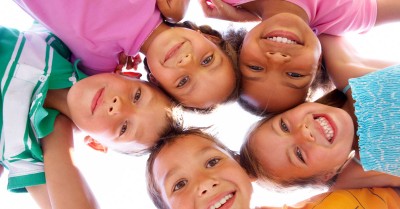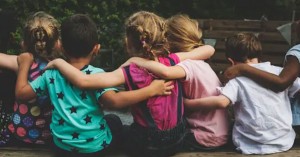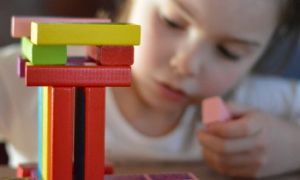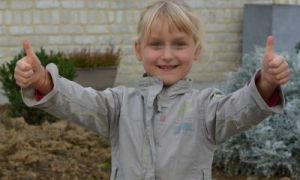This is a guide for educators on what to observe under each sub-learning outcome from the EYLF Framework Version 2, when a child is engaged in play and learning. Educators can plan experiences for the curriculum and for individual learning and gain an understanding of how children can achieve each individual outcome.
How Children Can Achieve EYLF Learning Outcome 1
1.1 Children feel safe, secure and supported
This is evident when children, for example:
- build secure attachments with one and then other familiar educators
- participate in familiar routines and rituals to make smooth transitions
- sense and respond to a feeling of belonging
- share ideas and information about their culture and cultural artefacts
- seek and connect with adults they trust to share their accomplishments and communicate their needs for comfort and assistance
- establish and maintain respectful, trusting relationships with other children and educators
- openly express their feelings and ideas in their interactions with others
- respond to ideas and suggestions from others
- initiate interactions and conversations with trusted educators
- confidently explore and engage with social and physical environments through relationships and play
- initiate and join in play
- explore aspects of identity through role play
- use home languages
1.2 Children develop their emerging autonomy, inter-dependence, resilience and agency
This is evident when children, for example:
- initiate exploration and independent learning
- show interest and curiosity through observing, listening, selecting and making choices
- demonstrate increasing awareness of the needs and rights of others
- are open to new challenges and discoveries
- increasingly cooperate and work collaboratively with others
- take considered risks in their decision-making and cope with the unexpected
- recognise their individual achievements and the achievements of others
- demonstrate an increasing capacity for self-regulation and self-soothing
- approach new safe situations with interest and confidence
- initiate negotiating and sharing behaviours
- persist and persevere in self-chosen tasks, including when faced with challenges and when first attempts are not successful
- cooperate and participate in routines and rituals
- show initiative by seeking information and asking questions
- learn how to stand up for themselves in appropriate ways.
1.3 Children respond to diversity with respect
This is evident when children, for example:
- show respect for others
- show interest in and explore the diversity of cultures, heritage, backgrounds, traditions and families
- become aware that diversity presents opportunities for choices and new understandings
- become aware of connections, similarities and differences between people
- explore Aboriginal and Torres Strait Islander children’s kinships systems, their relationships, and the connections that they have built with their own community
- listen to others’ ideas and respect different ways of being and doing
- practise inclusive ways of being with others and achieving coexistence
- notice and react in positive ways to similarities and differences among people
- become aware of their own and other children’s linguistic and cultural events, e.g. Diwali, Easter, Harmony Day, Chuseok, NAIDOC, Sorry Business
- participate in or celebrate community and sporting events such as the Paralympic Games
- investigate other cultures around them.
1.4 Children develop knowledgeable confident self-identities and a positive sense of self-worth
This is evident when children, for example:
- express and share pleasure and pride in their own efforts, achievements and accomplishments through language, gestures, facial expressions and/or movements
- feel recognised and respected for who they are
- explore different identities, roles and points of view in pretend play
- develop strong foundations in both the culture and language/s of their family and of the broader community without compromising their cultural identities
- reach out and communicate with trusted educators and familiar children for comfort assistance and companionship
- celebrate and share their contributions and achievements with others
- show curiosity and growing confidence in their identity as a learner
- share information about their family, culture, home languages and aspects that make them unique
- engage with Aboriginal and Torres Strait Islander Elders and community members to explore their own and others' social and cultural heritage
- take calculated risks in play and learning and begin to cope with the unexpected
- display a positive image of themselves, their families, culture and community
- acknowledge, share and celebrate Aboriginal and Torres Strait Islander traditions, customs and celebrations
1.5 Children learn to interact in relation to others with care, empathy and respect
This is evident when children, for example:
- show interest in other children and their play
- approach and initiate interactions with other children in order to form or be part of a group
- engage in and contribute to shared play experiences
- express a wide range of emotions, thoughts and views constructively
- help and offer care to other children
- recognise and name a range of feelings in themselves and others
- empathise with and express concern for others
- appreciate the need to take turns and wait so that others can have their turn
- co-use and collaborate with others when using digital technologies
- display awareness of and respect for others’ perspectives
- display awareness of and respect for children’s diverse worlds, e.g. culture, family structure, capabilities and strengths
- reflect on their actions and consider the consequences for others
- name and challenge unfair acts, and discrimination on behalf of themselves and others
- listen to others’ opinions or points of view
- recognise safe and unsafe situations
How Children Can Achieve EYLF Learning Outcome 2
2.1 Children develop a sense of connectedness to groups and communities and an understanding of their reciprocal rights and responsibilities as active and informed citizens
This is evident when children, for example:
- identify themselves as being part of family and community groups
- begin to recognise there is a diversity of cultures, traditions and family structures
- begin to recognise that they have a right to belong and contribute to many communities
- cooperate with others and negotiate roles and relationships in play episodes and group experiences
- take action to include and assist children in participating in social groups
- broaden their understanding of the world in which they live
- express an opinion
- contribute to decision-making and action-taking in matters that affect them
- build on their own social experiences to explore other ways of being
- participate in reciprocal relationships
- gradually learn to ‘read’ the feelings and behaviours of others and respond appropriately
- demonstrate a sense of belonging and comfort in their environments
- are playful and respond positively to others, reaching out for company and friendship
2.2 Children respond to diversity with respect
This is evident when children, for example:
- show respect for others
- show interest in and explore the diversity of cultures, heritage, backgrounds, traditions and families
- become aware that diversity presents opportunities for choices and new understandings
- become aware of connections, similarities and differences between people
- explore Aboriginal and Torres Strait Islander children’s kinships systems, their relationships, and the connections that they have built with their own community
- listen to others’ ideas and respect different ways of being and doing
- practise inclusive ways of being with others and achieving coexistence
- notice and react in positive ways to similarities and differences among people
- become aware of their own and other children’s linguistic and cultural events, e.g. Diwali, Easter, Harmony Day, Chuseok, NAIDOC, Sorry Business
- participate in or celebrate community and sporting events such as the Paralympic Games
- investigate other cultures around them.
2.3 Children become aware of fairness
This is evident when children, for example:
- appreciate the connections among people
- begin to understand expectations, setting rules and the rights of others
- become aware of ways in which people are included or excluded from physical and social environments
- understand what it means to be treated fairly and to treat others fairly
- develop the ability to recognise unfairness and bias and the capacity to act with compassion and kindness
- make choices and problem-solve to meet their needs in particular contexts
- consider and think critically about fair and unfair behaviour
- understand and evaluate ways in which texts construct identities and create stereotypes
- appreciate and respect different ways of knowing, being and doing
- investigate the cultural and linguistic diversity represented in their community through a range of creative expressions
- participate in the negotiation of decisions affecting them
- engage with concepts of citizenship, social justice and equity, e.g. taking action to help communities in distress following fires, floods and drought
- show empathy for those unfairly treated.
2.4 Children become socially responsible and show respect for the environment
This is evident when children, for example:
- use play to investigate and explore nature and the natural environment
- recognise they are part of ecosystems and care for local biodiversity
- participate with others to identify and address environmental challenges and problems, and contribute to group ideas and plans
- demonstrate an increasing knowledge of, and respect, for natural and constructed environments
- care for the Country and connect with animals, plants, lands and waterways
- learn and use Aboriginal or Torres Strait Islander names for the land, local plants and animals
- express their views about important topics and work together to problem solve and enact solutions within their communities
- explore, infer, predict and hypothesise in order to develop an increased understanding of the interdependence between land, people, plants and animals
- develop an awareness of the impact of human activity on environments and the interdependence of living things, e.g. marine debris and potential impact on marine life
- explore the basic needs of living things and how to protect them
- connect through language and culture with local Aboriginal and Torres Strait Islander Country
How Children Can Achieve EYLF Learning Outcome 3
3.1 Children become strong in their social, emotional and mental wellbeing
This is evident when children, for example:
- demonstrate trust and confidence in their interactions with others
- remain accessible to others at times of distress, confusion and frustration
- identify and seek out trusted people to communicate what upsets them, makes them uncomfortable or sad
- communicate their physical and emotional needs, e.g., hunger or thirst
- share humour, happiness and feelings of satisfaction
- seek out and accept new challenges, make new discoveries, and celebrate their own efforts and achievements and those of others
- increasingly cooperate and work collaboratively with others
- enjoy moments of solitude
- recognise their individual efforts and achievement
- make choices, accept challenges, take considered risks, manage change and cope with frustrations and the unexpected
- show an increasing capacity to understand, selfregulate and manage their emotions
- appreciate the feelings and needs of others
3.2 Children become strong in their physical learning and mental wellbeing
This is evident when children, for example:
- engage in increasingly complex coordination of body movements with sight, sounds and other sensory stimuli to engage with people and explore materials
- develop movement patterns, mobility and gross motor skills to manage and explore the physical environment
- combine gross and fine motor movement and balance to achieve increasingly complex patterns of activity, including dance, creative movement, drama and
- fundamental movement skills
- build core strength, physical coordination and stamina
- use their sensory perceptions, physical capabilities and dispositions with increasing integration, skill and purpose to explore and respond to their world, including
- finding new challenges and risks
- demonstrate spatial awareness and orient themselves, moving around and through indoor and outdoor environments confidently and safely
- manipulate equipment and manage tools with increasing competence and skill
- respond through movement to traditional and contemporary music, dance and storytelling
- move to the tempo and rhythm of the music
3.3 Children are aware of and develop strategies to support their own mental and physical health and personal safety
This is evident when children, for example:
- recognise and communicate their body needs, (e.g. thirst, hunger, rest, comfort, physical activity)
- are happy, healthy, safe and connected to others
- show awareness of healthy lifestyles and good nutrition
- show increasing independence and competence in personal hygiene
- show care and safety for themselves and others
- build strategies to calm the body and mind
- have agency and exercise choice about their sleep, rest and relaxation
- develop a sense of body autonomy and boundaries (e.g. my body belongs to me)
- learn ways to ask for and provide consent during everyday play
- distinguish safe and unsafe touches
- notice and label feelings/emotions in themselves and others
- learn how to tell or communicate to a trusted adult about things that upset them, make them uncomfortable or sad.
How Children Can Achieve EYLF Learning Outcome 4
4.1 Children develop a growth mindset and learning dispositions such as curiosity, cooperation, confidence, creativity, commitment, enthusiasm, persistence, imagination and reflexivity
This is evident when children, for example:
- express wonder and interest in their environments
- are curious and enthusiastic participants in their learning
- share their ideas with others and ask questions of adults
- use play to investigate, experiment, test hypotheses, imagine and explore ideas
- follow and extend their own interests with enthusiasm, energy and concentration
- initiate and contribute to play experiences emerging from their own ideas
- participate in a variety of rich and meaningful inquiry-based experiences
- explore diverse ways of knowing, being and doing in their learning
- persevere and experience the satisfaction of achievement
- persist even when they find a task difficult
- use positive self-talk when trying to overcome a problem or setback
- revisit previous learning experiences and plan new challenges
4.2 Children develop a range of learning and thinking skills and processes such as problem-solving, inquiry, experimentation, hypothesising, researching and investigating
This is evident when children, for example:
- use trial and error to explore different possibilities through ‘cause and effect’
- initiate investigative play to solve self-generated problems and discoveries
- apply a wide variety of thinking strategies to engage with situations and solve problems, and adapt these strategies to new situations
- create and use representation to organise, record and communicate mathematical ideas and concepts
- make predictions and generalisations about their daily activities, aspects of the natural world and environments, using patterns they generate or identify and communicate these using
- mathematical language and symbols
- explore their environment through asking questions, experimenting, investigating and using digital technologies
- connect with their local Aboriginal and Torres Strait Islander community (e.g. Elders, role models) to engage with stories about place-based history and culture
- manipulate objects and experiment with cause and effect, trial and error, and motion
- contribute to mathematical discussions and arguments
4.3 Children transfer and adapt what they have learned from one context to another
This is evident when children, for example:
- practice and imagine relationships and experiences in their daily lives through pretend or symbolic play
- engage with others to co-construct learning
- develop an ability to mirror, repeat and practice the actions of others, either immediately or later
- make connections between experiences, concepts and processes
- use the processes of play, reflection and investigation to solve problems
- apply generalisations from one situation to another
- try out strategies that were effective to solve problems in one situation in a new context
- transfer knowledge from one setting to another
- use strategies to reflect on and assess their learning and thinking.
4.4 Children resource their own learning through connecting with people, places, technologies and natural and processed materials
This is evident when children, for example:
- engage in learning relationships with a wide diversity of people
- use their senses and body movements to explore natural and built materials and environments
- experience the benefits and pleasures of shared learning explorations, investigations and imaginary play scenarios
- explore the purpose and function of a range of tools, media, sounds and graphics
- manipulate natural and manufactured materials and resources to investigate, take apart, assemble, invent and construct
- experiment with different technologies
- use digital technologies and media to investigate and problem solve
- explore ideas and theories using imagination, creativity and play
- use feedback from themselves and others to revise and build on an idea
- engage in meaningful conversations about natural and processed materials
- create and construct artwork in a sustainable way using natural and manufactured materials and tools, drawing on Aboriginal and Torres Strait Islander stories,
- history, culture, customs and celebrations
- retell or create simple stories using materials or drama to represent ideas
How Children Can Achieve EYLF Learning Outcome 5
5.1 Children interact verbally and non-verbally with others for a range of purposes
This is evident when children, for example:
- engage in enjoyable interactions using verbal and non-verbal language
- convey and construct messages with purpose and confidence, building on home/family and community literacies
- respond verbally and non-verbally to what they see, hear, touch, feel and taste
- use language and representations from play, music and art to share and project meaning
- contribute their ideas and experiences in play, small and large group discussions
- recount events in their life
- listen to and act upon simple directions
- attend and give cultural cues that they are listening to and understanding what is said to them
- are independent communicators who initiate Standard Australian English and home language conversations and demonstrate the ability to meet the listener’s needs
- interact with others to explore ideas and concepts, clarify and challenge thinking, negotiate and share new understandings
- exchange ideas, feelings and understandings using language and representations in play
5.2 Children engage with a range of texts and gain meaning from these texts
This is evident when children, for example:
- listen and respond to sounds and patterns in speech, stories and rhymes in context
- view and listen to printed, visual and multimedia texts and respond with relevant gestures, actions, comments and/or questions
- sing and chant rhymes, jingles and songs
- take on roles of literacy and numeracy users in their play
- begin to understand key literacy and numeracy concepts and processes, such as the sounds of language, letter-sound relationships, concepts of print and the ways that texts are structured
- explore texts from a range of different perspectives and begin to analyse the meanings
- actively use, engage with and share the enjoyment of language and texts in a range of ways
- recognise and engage with written and oral culturally constructed texts
- listen to and discuss stories about Aboriginal and Torres Strait Islander history, culture, ways of sustainability and care, customs and celebrations
- retell simple stories in a logical sequence using a range of material and expressive forms, e.g. blocks, dramatic play
- engage in pretend play that draws on the use of digital technologies.
5.3 Children express ideas and make meaning using a range of media
This is evident when children, for example:
- use language, sounds, gestures and movement to engage in play to imagine and create roles, scripts and ideas
- share the stories and symbols of their own culture and re-enact well-known stories
- use materials to create artworks (e.g. such as drawing, painting, sculpture, drama, dance, movement, music and storytelling) to express ideas and make meaning
- experiment with ways of expressing ideas and meaning using a range of media
- begin to use images and approximations of letters and words to convey meaning
- enjoy engaging with and sharing a wide variety of cultural texts including those authored by Traditional Owners
- display literacy behaviours by incorporating reading and writing approximations and viewing in their play (including digital technologies)
- view, listen and respond to simple printed, visual and multimedia texts or music and express how it makes them feel
- use simple tools and techniques to shape, assemble and join materials they are using
- explore a range of materials and their properties.
5.4 Children begin to understand how symbols and pattern systems work
This is evident when children, for example:
- use symbols in play to represent and make meaning
- begin to make connections between and see patterns in their feelings, ideas, words and actions and those of others
- notice and predict the patterns of regular routines and the passing of time
- develop an understanding that symbols are a powerful means of communication and that ideas, thoughts and concepts can be represented through them
- begin to be aware of the relationships between oral, written and visual representations
- begin to recognise patterns and relationships and the connections between them
- begin to sort, categorise, order and compare collections and events and attributes of objects and materials in their social and natural worlds
- begin to identify and use the names of basic colours and simple shapes
- listen and respond to sounds and patterns in speech, stories and rhyme
- draw on the memory of a sequence to complete a task
- draw on their experiences in constructing meaning using symbols
- identify Aboriginal and Torres Strait Islander signs and symbols relevant to their area and investigate and begin to recognise with assistance representations of
- stereotypes or narrow depictions of diversity
5.5 Children use digital technologies and media to access information, investigate ideas and represent their thinking
This is evident when children, for example:
- identify technologies and their use in everyday life
- incorporate real or imaginary technologies as features of their play
- use digital technologies to access images and information, explore diverse perspectives and make sense of their world
- develop simple skills to operate digital devices, such as turning on and taking a photo with a tablet
- use digital technologies and media for creative expression (e.g. designing, drawing, composing)
- engage with technologies and media for fun and social connection
- identify basic icons and keys (e.g. delete button) and use them to support their navigation (e.g. click, swipe, home, scroll) and understand these terms
- adopt collaborative approaches in their learning about and with digital technologies.
Further Reading
EYLF Learning Outcomes Version 2.0 - The following articles provide a list of the 5 EYLF Learning Outcomes and their sub-outcomes (Version 2.0).
Free EYLF Version 2.0 Posters and Cheat Sheets - The following provides a list of cheat sheets and free printables based on EYLF Outcomes Version 2.0. These can be used as a reference point for Educators. They can also be used to refer to when documenting and planning.
Reference:
Belonging, Being and Becoming, Frameworks For Learning Version 2.0, ACECQA 2023







 Here is the list of the EYLF Learning Outcomes that you can use as a guide or reference for your documentation and planning. The EYLF
Here is the list of the EYLF Learning Outcomes that you can use as a guide or reference for your documentation and planning. The EYLF The EYLF is a guide which consists of Principles, Practices and 5 main Learning Outcomes along with each of their sub outcomes, based on identity,
The EYLF is a guide which consists of Principles, Practices and 5 main Learning Outcomes along with each of their sub outcomes, based on identity, This is a guide on How to Write a Learning Story. It provides information on What Is A Learning Story, Writing A Learning Story, Sample
This is a guide on How to Write a Learning Story. It provides information on What Is A Learning Story, Writing A Learning Story, Sample One of the most important types of documentation methods that educators needs to be familiar with are “observations”. Observations are crucial for all early childhood
One of the most important types of documentation methods that educators needs to be familiar with are “observations”. Observations are crucial for all early childhood To support children achieve learning outcomes from the EYLF Framework, the following list gives educators examples of how to promote children's learning in each individual
To support children achieve learning outcomes from the EYLF Framework, the following list gives educators examples of how to promote children's learning in each individual Reflective practice is learning from everyday situations and issues and concerns that arise which form part of our daily routine while working in an early
Reflective practice is learning from everyday situations and issues and concerns that arise which form part of our daily routine while working in an early Within Australia, Programming and Planning is reflected and supported by the Early Years Learning Framework. Educators within early childhood settings, use the EYLF to guide
Within Australia, Programming and Planning is reflected and supported by the Early Years Learning Framework. Educators within early childhood settings, use the EYLF to guide This is a guide for educators on what to observe under each sub learning outcome from the EYLF Framework, when a child is engaged in
This is a guide for educators on what to observe under each sub learning outcome from the EYLF Framework, when a child is engaged in When observing children, it's important that we use a range of different observation methods from running records, learning stories to photographs and work samples. Using
When observing children, it's important that we use a range of different observation methods from running records, learning stories to photographs and work samples. Using The Early Years Learning Framework describes the curriculum as “all the interactions, experiences, activities, routines and events, planned and unplanned, that occur in an environment
The Early Years Learning Framework describes the curriculum as “all the interactions, experiences, activities, routines and events, planned and unplanned, that occur in an environment


